Important Reminder
Photographs of missing children. The Internal Revenue Service is a proud partner with the National Center for Missing and Exploited Children. Photographs of missing children selected by the Center may appear in this publication on pages that would otherwise be blank. You can help bring these children home by looking at the photographs and calling 1-800-THE-LOST (1-800-843-5678) if you recognize a child.
Introduction
The federal income tax is a pay-as-you-go tax. This means you must pay the tax as you earn or receive income during the year.
As a wage earner, you pay federal income tax by having it withheld from your pay during the year. This is your withholding. Your withholding is based on the number of allowances you claim when you file Form W-4, Employee's Withholding Allowance Certificate, with your employer.
Comments and suggestions. We welcome your comments about this publication and your suggestions for future editions.
You can e-mail us while visiting our web site at
www.irs.gov.
You can write to us at the following address:
Internal Revenue Service
Tax Forms and Publications
W:CAR:MP:FP
1111 Constitution Ave. NW
Washington, DC 20224
We respond to many letters by telephone. Therefore, it would be helpful if you would include your daytime phone number, including the area code, in your correspondence.
Purpose of This Publication
The purpose of this publication is to help you check your withholding and, if necessary, prepare Form W-4 to adjust your withholding. When you first begin a job, you must complete a Form W-4 and give it to your employer to establish your initial withholding. You can adjust your withholding by filing a new Form W-4 with your employer at any time.
Note: You do not have to file Form W-4 each year unless you need to adjust your withholding.
Checking Your Withholding
The purpose of this section is to explain why, when, and how to check your withholding to see if you will have enough, but not too much, tax withheld for 2003.
Why Should I Check My Withholding?
You should try to have your withholding match your actual tax liability. If not enough tax is withheld, you will owe tax at the end of the year and may have to pay interest and a penalty. If too much tax is withheld, you will lose the use of that money until you get your refund.
You should check your withholding if there are personal or financial changes in your life or changes in the law that might change your tax liability. See Figure 1.
When Should I Check My Withholding?
The earlier in the year you check your withholding, the easier it is to get the right amount of tax withheld.
You may want to check your withholding when any of the following situations occur.
- You receive a paycheck stub (statement) covering a full pay period in 2003, showing tax withheld based on 2003 tax rates.
- You prepare your 2002 tax return and get a:
- Big refund, or
- Balance due that is:
- More than you can comfortably pay, or
- Subject to a penalty.
- There are changes in your life or financial situation that affect your tax liability. See Figure 1.
- There are changes in the tax law that affect your tax liability. See Tax Law Changes, later.
 Caution: You must give your employer a new Form W-4 to adjust your withholding within 10 days of any event that decreases the number of withholding allowances you can claim, such as your divorce if you are claiming married status.
Caution: You must give your employer a new Form W-4 to adjust your withholding within 10 days of any event that decreases the number of withholding allowances you can claim, such as your divorce if you are claiming married status.
Tax Law Changes
If there are tax law changes that increase your tax for 2003 and you do not increase your withholding, you may have to pay tax when you file your return. If there are changes that decrease your tax for 2003 and you do not decrease your withholding, you may get a larger refund. You can get this money back earlier by reducing your withholding.
For information about changes in the law for 2002 and 2003, get Publication 553, Highlights of 2002 Tax Changes, or visit the IRS Web Site at www.irs.gov.
How Do I Check My Withholding?
You can use the worksheets and tables in this publication to see if you are having the right amount of tax withheld.
Follow these steps.
- Fill out Worksheet 1 to project your total federal income tax liability for 2003.
- Fill out Worksheet 2 to project your total federal withholding for 2003 and to compare your projected tax to your projected withholding.
If you are not having enough tax withheld, Worksheet 2 will show you how much more to have withheld each payday.
If you are having more tax withheld than you need to have withheld, Worksheet 2 will refer you to How Do I Decrease My Withholding.
What If Not Enough Tax Is Being Withheld?
If not enough tax will be withheld, you should give your employer a Form W-4 showing either a reduced number of withholding allowances or an additional amount to be withheld from your pay. See How Do I Increase My Withholding, later.
There is a good chance you are not having enough tax withheld if:
- You have more than one job at a time,
- Your spouse also works,
- You have income not subject to withholding, such as capital gains, rental income, interest, and dividends, or
- You owe other taxes such as self-employment tax or household employment taxes.
If your employer cannot withhold enough additional tax from your pay, you may need to make estimated tax payments. This might be the case if your pay is low and you have substantial nonwage income, such as interest, dividends, capital gains, or earnings from self-employment. For more information on estimated tax, get Publication 505, Tax Withholding and Estimated Tax.
What If Too Much Tax Is Being Withheld?
If too much tax is withheld, you may receive a large refund when you file your return. If you would prefer to receive the money during the year, you may be able to decrease your withholding by giving your employer a new Form W-4.
There is a good chance you are having too much tax withheld if:
- You got a big refund for 2002 and your income, adjustments, deductions, and credits will remain about the same this year,
- Your income will remain about the same as last year, but your adjustments, deductions, or credits will increase significantly, or
- You got a refund last year; your income, adjustments, and deductions will remain about the same as last year; but you will qualify for one or more tax credits this year that you did not qualify for last year.
Note. Adjustments to income are listed on Form 1040 and Form 1040A near the bottom of page 1. Itemized deductions appear on Schedule A (Form 1040). Credits appear on page 2 of Form 1040 and Form 1040A. See also Figures 1 and 2.
You may want to check your withholding after events in your life that are likely to affect your tax liability. Examples are listed below.
Figure 1. Personal and Financial Factors
| Factor |
Examples |
| Lifestyle change |
Marriage Divorce Birth or adoption of child Loss of an exemption Purchase of a new home Retirement |
| Wage income |
You or your spouse start or stop working, or start or stop a second job |
| Increased or decreased income not subject to withholding |
Interest income Dividends Capital gains Self-employment income IRA distributions (including Roth IRA conversion distributions) |
| Increased or decreased adjustments to income |
IRA deduction Student loan interest deduction Alimony expense |
| Increased or decreased itemized deductions or tax credits |
Medical expenses Taxes Interest expense Gifts to charity Job expenses Education credit |
Adjusting Your Withholding
The purpose of this section is to explain how to adjust your withholding.
If you are not having enough tax withheld or you are having too much tax withheld, you should either increase or decrease your withholding.
How Do I Adjust My Withholding?
You increase or decrease your withholding by filling out a new Form W-4 and giving it to your employer. You can use the worksheets and information in this publication to help you complete Form W-4. You can complete the Form W-4 near the end of this publication and give it to your employer.
How Do I Increase My Withholding?
There are two ways to increase your withholding. You can:
- Decrease the number of allowances you claim on line 5 of Form W-4, or
- Enter an additional amount that you want withheld from each paycheck on line 6 of Form W-4 .
How to request an additional amount to be withheld. You can request that an additional amount be withheld from each paycheck by following these steps.
- Complete Worksheets 1 and 2.
- Complete a new Form W-4 if the amount on line 5 of Worksheet 2 is more than you want to have to pay or would cause a penalty when you file your tax return for 2003.
- Enter on line 5 of the new Form W-4 the same number of withholding allowances your employer now uses for your withholding. This is the number of allowances you entered on the last Form W-4 you gave your employer.
- Enter on line 6 of the new Form W-4 the amount from line 6 of Worksheet 2.
- Give your newly completed Form W-4 to your employer.
If you have this additional amount withheld from your pay each payday, you should avoid owing a large amount at the end of the year.
Example. Using Worksheets 1 and 2, Steve figures that his 2003 tax liability will be $5,000 and that his withholding for the year will be $4,700. Steve's tax will be underwithheld by $300 ($5,000 - $4,700). He will have to pay this amount when he files his 2003 tax return or he can increase his withholding. Steve gets a new Form W-4 from his employer, who tells him that there are 50 paydays remaining in the year. Steve completes the form as before, and enters the same number of withholding allowances as before, then enters $6 ($300 ÷ 50) on line 6 of the form. This is the additional amount to be withheld from his pay each payday. He gives the completed form to his employer.
What if I have more than one job or my spouse also has a job? You are likely to need to increase your withholding if you have more than one job (or if you are married filing jointly and your spouse also works). If this is the case, you can increase your withholding for one or more of the jobs.
You can apply the amount on line 5 of Worksheet 2 to only one job or divide it between the jobs any way you wish. For each job, determine the extra amount that you want to apply to that job and divide that amount by the number of paydays remaining in 2003 for that job. This will give you the additional amount to enter on line 6 of the Form W-4 you will file for that job. You need to file a Form W-4 for each job for which you are changing your withholding.
Example. Meg Green works in a store. Her husband, John, works full time in manufacturing. They file a joint income tax return. When they fill out Worksheets 1 and 2, they find they will not have enough tax withheld. They can divide the amount on line 6 of Worksheet 2 any way they want. They can enter an additional amount on either of their Forms W-4, or divide it between them. They decide to have all of the additional amount from line 6 withheld from John's wages, so they enter on line 6 of his W-4 the number from line 6 of their completed Worksheet 2. Both claim the same number of allowances as before.
How Do I Decrease My Withholding?
If you expect to have more tax withheld than your projected tax liability for 2003, you may be able to decrease your withholding by increasing the number of allowances that you claim on Form W-4.
 You can only claim the number of allowances to which you are entitled. To see if you can decrease your withholding by increasing your allowances, see the Form W-4 instructions and the rest of this publication.
You can only claim the number of allowances to which you are entitled. To see if you can decrease your withholding by increasing your allowances, see the Form W-4 instructions and the rest of this publication.
How do I increase the number of allowances I can claim? You figure and increase the number of withholding allowances you are entitled to claim as follows.
- Complete Worksheets 1 and 2.
- If your projected withholding is significantly more than your projected tax, get a new Form W-4 (or use the one in the back of this publication).
- Complete the Personal Allowances Worksheet on Form W-4.
- Use the remainder of the worksheets in this publication, as applicable.
- Complete the Deductions and Adjustments Worksheet on Form W-4 if you plan to itemize deductions, claim adjustments to income, or claim tax credits from Worksheet 7 on your 2003 return.
- Complete the Two-earner/two-job worksheet on Form W-4 if you meet the criteria on line H of the Form W-4 Personal Allowances Worksheet.
- Fill out Form W-4.
- Enter the number of allowances you are entitled to claim on line 5 of Form W-4.
- If the number of allowances you are entitled to claim is different from the number you are already claiming, give the newly completed Form W-4 to your employer.
What if I can claim tax credits? Figure 2 shows tax credits you may be able to use to reduce your withholding. The Form W-4 Personal Allowances Worksheet only provides rough adjustments for the child and dependent care credit (line F) and the child tax credit (line G). Use Worksheet 7 to take these credits into account more accurately and also take other credits into account.
 If you take the child and dependent care credit into account on Worksheet 7, enter -0- on line F of the Personal Allowances Worksheet. If you take the child tax credit into account on Worksheet 7, enter -0- on line G of the Personal Allowances Worksheet.
If you take the child and dependent care credit into account on Worksheet 7, enter -0- on line F of the Personal Allowances Worksheet. If you take the child tax credit into account on Worksheet 7, enter -0- on line G of the Personal Allowances Worksheet.
To figure the additional amount to add on line 5 of the Form W-4 Deductions and Adjustments Worksheet for your tax credits, complete Worksheet 7. Then complete the Form W-4 Deductions and Adjustments Worksheet and the rest of Form W-4.
Example. Brett and Alyssa are married and expect to file a joint return for 2002. Their combined estimated wages are $68,000. Their projected tax credits include a child and dependent care credit of $960 and a mortgage interest credit of $1,700.
They use Worksheet 7 to see whether they can convert their tax credits into additional allowances.
- They enter their expected child and dependent care credit, $960, on line 1 of Worksheet 7.
- They enter their expected mortgage interest credit, $1,700, on line 8 of Worksheet 7.
- They add these credits and enter the total, $2,660, on line 10.
- Because they are married filing a joint return, they use the table for married filing jointly.
- They see that their combined estimated wages, $68,000, falls between $65,000 and $132,000, and that the number to the right of this range is 3.7.
- They enter 3.7 on line 11.
- They multiply line 10 by line 11 and enter the result, $9,842, on line 12.
- They take the result on line 12, and add it to their other adjustments on line 5 of the Deductions and Adjustments Worksheet on Form W-4.
- They finish filling out the Deductions and Adjustments Worksheet.
- Because they chose to account for their child and dependent care credit this way, they enter -0- on line F of the Personal Allowances Worksheet.
When Will My New Form W-4 Go Into Effect?
If the change is for the current year, your employer must put your new Form W-4 into effect no later than the start of the first payroll period ending on or after the 30th day after the day on which you give your employer your revised Form W-4.
If the change is for next year, your new Form W-4 will not take effect until next year.
Figure 2. Tax Credits
| Credit |
For more information, see ... |
| Credit for child and dependent care expenses |
Publication 503, Child and dependent Care Expenses |
| Credit for the elderly or the disabled |
Publication 524, Credit for the Elderly or the Disabled |
| Child tax credit (including additional child tax credit) |
Instructions for Form 1040 or Form 1040A |
| Education credits |
Publication 970, Tax Benefits for Education |
| Adoption credit |
Publication 968, Tax Benefits for Adoption |
| Foreign tax credit, except any credit that applies to wages not subject to U.S. income tax withholding because they are subject to income tax withholding by a foreign country |
Publication 514, Foreign Tax Credit for Individuals |
| Retirement savings contributions credit |
Publication 590, Individual Retirement Arrangements (IRAs) |
| Mortgage interest credit |
Publication 530, Tax Information for First-Time Homeowners |
| General business credit |
Form 3800, General Business Credit |
| Qualified electric vehicle credit |
Form 8834 Instructions |
| Credit for prior year minimum tax if you paid alternative minimum tax in an earlier year |
Form 8801 Instructions |
| Earned income credit, unless you requested advance payment of the credit |
Publication 596, Earned Income Credit |
Figure 3. Worksheets and Tables This publication contains worksheets and tables for you to figure and adjust your tax withholding. The list below describes how each of them is used.
| Use ... |
To ... |
| Worksheet 1. Projected Tax for 2003 |
Project the taxable income you will have for 2003 and the amount of tax you will have to pay on that income. |
| Worksheet 2. Projected Withholding for 2003 |
Project the amount of federal income tax that you will have withheld in 2003, compare your projected withholding with your projected tax, and determine whether the amount withheld each payday should be adjusted. |
| Worksheets 1a, 1b, 1c, and 1d. Tax Rate Schedule Worksheets for 2003 |
Project the amount of tax you will be liable for on your projected income for your filing status. |
| Worksheet 3. Itemized Deductions Limit |
Figure the amount of your projected itemized deductions on Schedule A (Form 1040) if they are limited because your projected adjusted gross income is more than $139,500 ($69,750 if married filing separately). |
| Worksheet 4. Exemptions Phaseout |
Figure the value of your projected exemptions if your exemptions are limited because your projected adjusted gross income for your projected filing status is more than: $139,500 if single; $209,250 if married filing jointly or qualifying widow(er); $104,625 if married filing separately; or $174,400 if head of household. |
| Worksheet 5. Figuring Tax If You Expect To Have Capital Gain |
Figure projected tax on all taxable income if you expect to have a capital gain in 2003. |
| Worksheet 6. Self-Employment Tax |
Figure your projected self-employment tax for 2003 if you and/or your spouse are self-employed in 2003 and your own wages and self-employment income for 2003 will be more than $87,000, or your spouse's wages and self-employment income will be more than $87,000. |
| Worksheet 7. Converting Credits to Withholding Allowances |
Figure how much of an adjustment to make to line 5 of the Deductions and Adjustments Worksheet on Form W-4 to account for your projected tax credits which are not otherwise taken into consideration. |
| Tables 1, 2, and 3. Standard Deduction Tables for 2003 |
Determine your projected standard deduction for 2003. Do not use this table if you plan to itemize your deductions. |
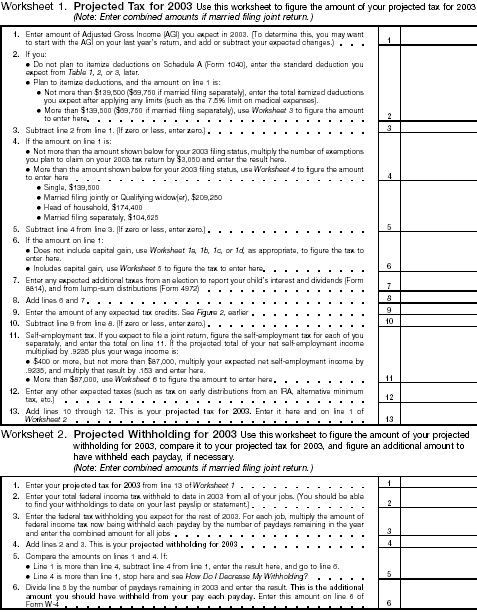
Worksheets 1 and 2
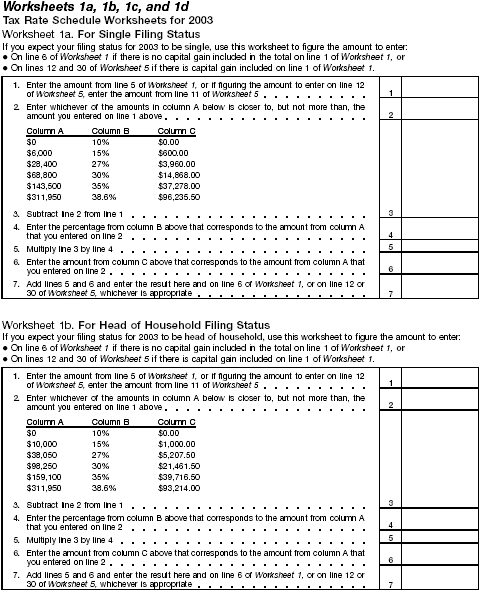
Worksheets 1a and 1b Tax Rate Schedules for S and HoH
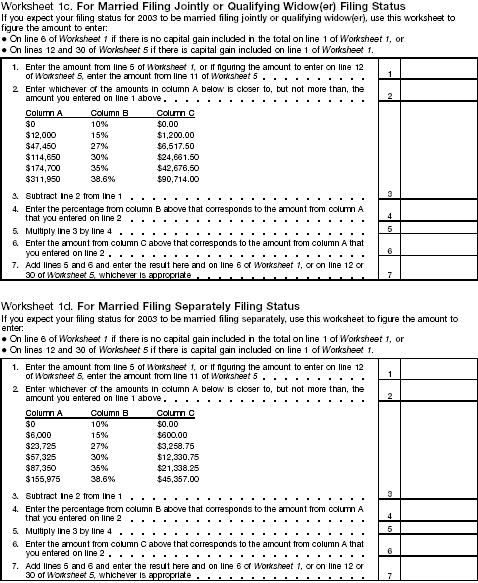
Worksheets 1c and 1d Tax Rate Schedules for MFJ and MFS
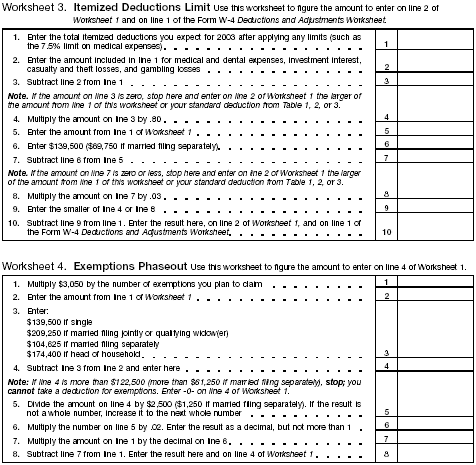
Worksheets 3 and 4 — Itemized Deductions and Exemptions Phaseout
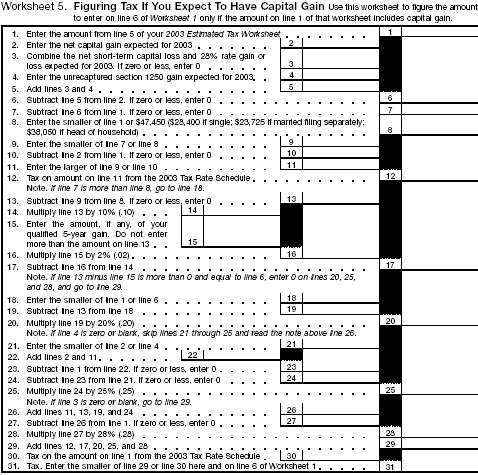
Worksheet 5 —Figuring Tax If You Expect to Have Capital Gain
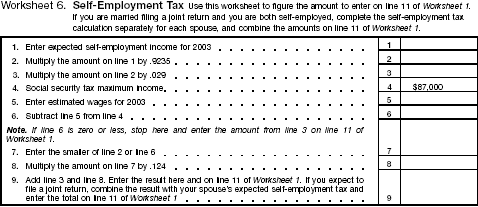
Self-employment Tax
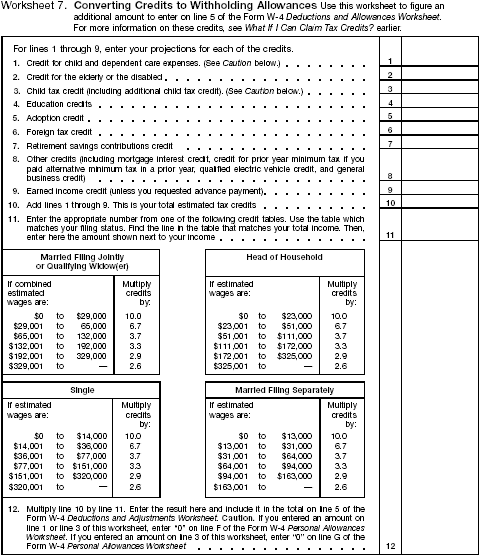
Converting Credits To Withholding Allowances
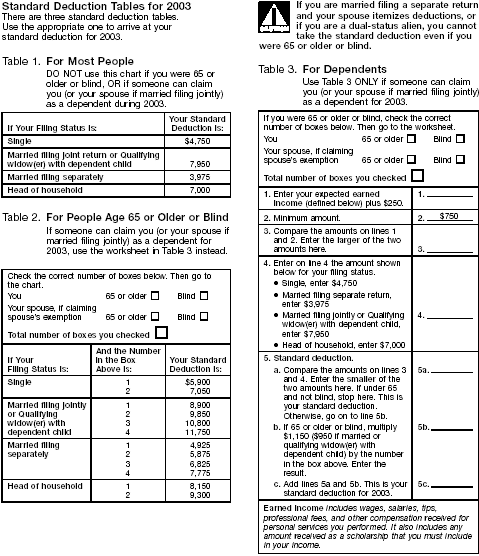
Standard Deduction Tables for 2003
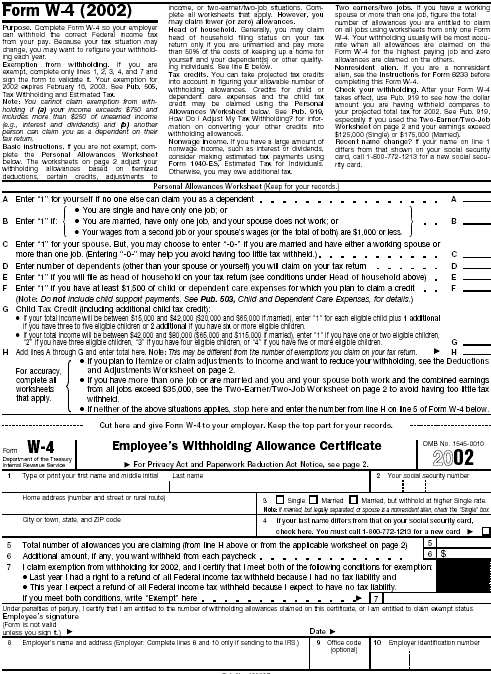
Blank Form W–4 page 1Form:Form: W–4
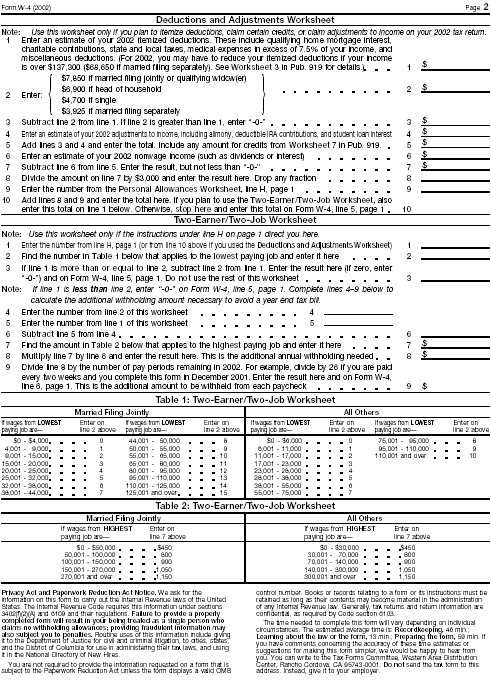
blank Form W–4 page 2
How To Get Tax Help
You can get help with unresolved tax issues, order free publications and forms, ask tax questions, and get more information from the IRS in several ways. By selecting the method that is best for you, you will have quick and easy access to tax help.
Contacting your Taxpayer Advocate. If you have attempted to deal with an IRS problem unsuccessfully, you should contact your Taxpayer Advocate.
The Taxpayer Advocate represents your interests and concerns within the IRS by protecting your rights and resolving problems that have not been fixed through normal channels. While Taxpayer Advocates cannot change the tax law or make a technical tax decision, they can clear up problems that resulted from previous contacts and ensure that your case is given a complete and impartial review.
To contact your Taxpayer Advocate:
- Call the Taxpayer Advocate at 1-877-777-4778.
- Call, write, or fax the Taxpayer Advocate office in your area.
- Call 1-800-829-4059 if you are a TTY/TDD user.
For more information, see Publication 1546, The Taxpayer Advocate Service of the IRS.
Free tax services. To find out what services are available, get Publication 910, Guide to Free Tax Services. It contains a list of free tax publications and an index of tax topics. It also describes other free tax information services, including tax education and assistance programs and a list of TeleTax topics.
 Personal computer. With your personal computer and modem, you can access the IRS on the Internet at www.irs.gov. While visiting our web site, you can:
Personal computer. With your personal computer and modem, you can access the IRS on the Internet at www.irs.gov. While visiting our web site, you can:
- See answers to frequently asked tax questions or request help by e-mail.
- Download forms and publications or search for forms and publications by topic or keyword.
- Order IRS products on-line.
- View forms that may be filled in electronically, print the completed form, and then save the form for recordkeeping.
- View Internal Revenue Bulletins published in the last few years.
- Search regulations and the Internal Revenue Code.
- Receive our electronic newsletters on hot tax issues and news.
- Learn about the benefits of filing electronically (IRS e-file).
- Get information on starting and operating a small business.
You can also reach us with your computer using File Transfer Protocol at ftp.irs.gov.
 TaxFax Service. Using the phone attached to your fax machine, you can receive forms and instructions by calling 703-368-9694. Follow the directions from the prompts. When you order forms, enter the catalog number for the form you need. The items you request will be faxed to you.
TaxFax Service. Using the phone attached to your fax machine, you can receive forms and instructions by calling 703-368-9694. Follow the directions from the prompts. When you order forms, enter the catalog number for the form you need. The items you request will be faxed to you.
For help with transmission problems, call the FedWorld Help Desk at 703-487-4608.
 Phone. Many services are available by phone.
Phone. Many services are available by phone.
- Ordering forms, instructions, and publications. Call 1-800-829-3676 to order current and prior year forms, instructions, and publications.
- Asking tax questions. Call the IRS with your tax questions at 1-800-829-1040.
- Solving problems. Take advantage of Everyday Tax Solutions service by calling your local IRS office to set up an in-person appointment at your convenience. Check your local directory assistance or www.irs.gov for the numbers.
- TTY/TDD equipment. If you have access to TTY/TDD equipment, call 1-800-829-4059 to ask tax questions or to order forms and publications.
- TeleTax topics. Call 1-800-829-4477 to listen to pre-recorded messages covering various tax topics.
Evaluating the quality of our telephone services. To ensure that IRS representatives give accurate, courteous, and professional answers, we use several methods to evaluate the quality of our telephone services. One method is for a second IRS representative to sometimes listen in on or record telephone calls. Another is to ask some callers to complete a short survey at the end of the call.
 Walk-in. Many products and services are available on a walk-in basis.
Walk-in. Many products and services are available on a walk-in basis.
- Products. You can walk in to many post offices, libraries, and IRS offices to pick up certain forms, instructions, and publications. Some IRS offices, libraries, grocery stores, copy centers, city and county governments, credit unions, and office supply stores have an extensive collection of products available to print from a CD-ROM or photocopy from reproducible proofs. Also, some IRS offices and libraries have the Internal Revenue Code, regulations, Internal Revenue Bulletins, and Cumulative Bulletins available for research purposes.
- Services. You can walk in to your local IRS office to ask tax questions or get help with a tax problem. Now you can set up an appointment by calling your local IRS office number and, at the prompt, leaving a message requesting Everyday Tax Solutions help. A representative will call you back within 2 business days to schedule an in-person appointment at your convenience.
 Mail. You can send your order for forms, instructions, and publications to the Distribution Center nearest to you and receive a response within 10 workdays after your request is received. Find the address that applies to your part of the country.
Mail. You can send your order for forms, instructions, and publications to the Distribution Center nearest to you and receive a response within 10 workdays after your request is received. Find the address that applies to your part of the country.
- Western part of U.S.:
Western Area Distribution Center
Rancho Cordova, CA 95743-0001
- Central part of U.S.:
Central Area Distribution Center
P.O. Box 8903
Bloomington, IL 61702-8903
- Eastern part of U.S. and foreign addresses:
Eastern Area Distribution Center
P.O. Box 85074
Richmond, VA 23261-5074
 CD-ROM for tax products. You can order IRS Publication 1796, Federal Tax Products on CD-ROM, and obtain:
CD-ROM for tax products. You can order IRS Publication 1796, Federal Tax Products on CD-ROM, and obtain:
- Current tax forms, instructions, and publications.
- Prior-year tax forms and instructions.
- Popular tax forms that may be filled in electronically, printed out for submission, and saved for recordkeeping.
- Internal Revenue Bulletins.
The CD-ROM can be purchased from National Technical Information Service (NTIS) by calling 1-877-233-6767 or on the Internet at http://www.irs.gov/cdorders. The first release is available in early January and the final release is available in late February.
 CD-ROM for small businesses. IRS Publication 3207, Small Business Resource Guide, is a must for every small business owner or any taxpayer about to start a business. This handy, interactive CD contains all the business tax forms, instructions and publications needed to successfully manage a business. In addition, the CD provides an abundance of other helpful information, such as how to prepare a business plan, finding financing for your business, and much more. The design of the CD makes finding information easy and quick and incorporates file formats and browsers that can be run on virtually any desktop or laptop computer.
CD-ROM for small businesses. IRS Publication 3207, Small Business Resource Guide, is a must for every small business owner or any taxpayer about to start a business. This handy, interactive CD contains all the business tax forms, instructions and publications needed to successfully manage a business. In addition, the CD provides an abundance of other helpful information, such as how to prepare a business plan, finding financing for your business, and much more. The design of the CD makes finding information easy and quick and incorporates file formats and browsers that can be run on virtually any desktop or laptop computer.
It is available in March. You can get a free copy by calling 1-800-829-3676 or by visiting the website at www.irs.gov/smallbiz.
First
Publication Index | 2002 Tax Help Archives | Tax Help Archives | Home

 Caution: You must give your employer a new Form W-4 to adjust your withholding within 10 days of any event that decreases the number of withholding allowances you can claim, such as your divorce if you are claiming married status.
Caution: You must give your employer a new Form W-4 to adjust your withholding within 10 days of any event that decreases the number of withholding allowances you can claim, such as your divorce if you are claiming married status. 









 Personal computer. With your personal computer and modem, you can access the IRS on the Internet at www.irs.gov. While visiting our web site, you can:
Personal computer. With your personal computer and modem, you can access the IRS on the Internet at www.irs.gov. While visiting our web site, you can:  TaxFax Service. Using the phone attached to your fax machine, you can receive forms and instructions by calling 703-368-9694. Follow the directions from the prompts. When you order forms, enter the catalog number for the form you need. The items you request will be faxed to you.
TaxFax Service. Using the phone attached to your fax machine, you can receive forms and instructions by calling 703-368-9694. Follow the directions from the prompts. When you order forms, enter the catalog number for the form you need. The items you request will be faxed to you.
 Phone. Many services are available by phone.
Phone. Many services are available by phone.  Walk-in. Many products and services are available on a walk-in basis.
Walk-in. Many products and services are available on a walk-in basis.  Mail. You can send your order for forms, instructions, and publications to the Distribution Center nearest to you and receive a response within 10 workdays after your request is received. Find the address that applies to your part of the country.
Mail. You can send your order for forms, instructions, and publications to the Distribution Center nearest to you and receive a response within 10 workdays after your request is received. Find the address that applies to your part of the country.  CD-ROM for tax products. You can order IRS Publication 1796, Federal Tax Products on CD-ROM, and obtain:
CD-ROM for tax products. You can order IRS Publication 1796, Federal Tax Products on CD-ROM, and obtain: